Historical Background:
During the 18th century, Peter the Great aimed to make Russia a major European power through modernization and expansion. As part of his reforms, he brought western European music to Russia. The subsequent period of time was marked by classical music styles, mainly from Italy and Germany. It was not until the 19th century that Russia strove to distinguish itself musically. A movement of romantic nationalism (also national romanticism or identity nationalism) emerged which "provided a series of answers to the 19th-century search for styles that would be culturally meaningful and evocative, yet not merely historicist." A group of Russian composers called the "Mighty Five" formed to compose and popularize Russian national tradition in classical music. Much of the group's works were based on Russian history, fairy tales, and folk tunes.
In the early 20th century, rapid growth in Russia brought about industrialism, the rise of a middle class, and a weakened government (especially after WWI). This created opportunity, uncertainty, and increased consciousness. In 1917, the Russian Revolution started and major political, economic, and social changes were taking place. During this time, Russian music also changed dramatically. The 1920's was an era of musical experimentation.
Image Source: http://englishrussia.com/images/cathedral_blowup/1.jpg
Russian Ballet:
Ballet was originally intended for entertaining the royal court. In the early 19th century, the theaters were opened up to anyone who could afford a ticket.
The Ballets Russes (French for "The Russian Ballets") was a ballet company established in 1909 by impresario Serge Diaghilev. It was distinguished for its highly skilled dancers and reknowned choreographers. In addition, Diaghilev employed many great composers, perhaps most notably, Igor Stravinsky, now recognized as the premier composer of the 20th century. After Diaghilev's death in 1929, the dancers were scattered and the company was claimed by its creditors.
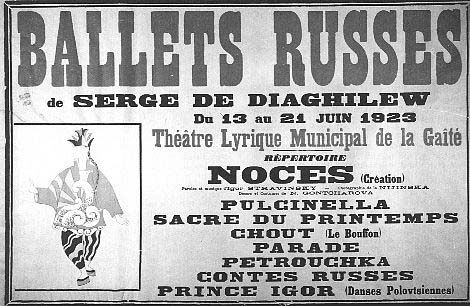
The Ballets Russes characterized and reformed many aspects of ballet: the male dancer returned, work was not only about technique but also expressiveness, freedom of movement, importance of the individual was stressed, pieces sought to express a single theme throughout, choreographers and dancers collaborated with set designers and musicians, and Russian themes were reflected.
Image Source: http://www.hatii.arts.gla.ac.uk/MultimediaStudentProjects/00-01/9705226m/mmcourse/project/images/ballets.r.poster.jpg
The following playlist is chronologically comprised of music compositions from the Ballets Russes:
1. Les Sylphides. By Frédéric Chopin. Chor. by Michel Fokine. Cond. Nikolai Rimsky-Korsakov. Ballets Russes. Théâtre du Châtelet, Paris. 2 June 1909.
Les Sylphides was the first ballet to be described as a "romantic reverie" - daydream-like or a state of abstracted musing. It is a one-act ballet with no plot; white-clad sylphs dance with a poet in the moonlight of a forest. In the clip of the ballet, Chopin's Nocturne in A flat major, Op. 32, No. 2 is played. The beginning and end have sweetly floating strings, while the middle of the song has a hint of gloominess and there is alternation between wind instruments and strings.
(Nocturne (French for "nocturnal") is a composition inspired by, or representative, of the night.)
2. L'Oiseau de feu [The Firebird]. By Igor Stravinsky. Chor. by Michel Fokine. Cond. Gabriel Pierné. Ballets Russes. Opéra Garnier, Paris. 25 June 1910.
This ballet score is 45 minutes in total and was originally written for a very large orchestra, including quadruple woodwind, three harps, and piano. The portion in the clip is beautifully somber and quiet, though there are moments of intensity. L'Oiseau de feu is based on a Russian folk tale about a firebird that is both a blessing and curse to its captor. It was a breakthrough success and marked the beginning of the collaboration between Stravinsky and Diaghilev.
3. Carnaval. By Robert Schumann. Chor. by Michel Fokine. Ballets Russes. Pavlov Hall, Saint-Petersburg. 5 Mar. 1910.
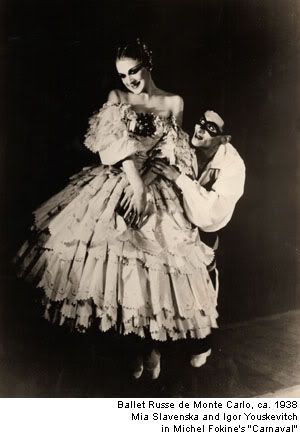 This piece, written as a piano solo, has a lighter and more upbeat sound. Schumann wrote it to represent masked people at Carnival, a festival before Lent. He gave musical expression to himself, his friends and colleagues, and characters from improvised Italian comedy.
This piece, written as a piano solo, has a lighter and more upbeat sound. Schumann wrote it to represent masked people at Carnival, a festival before Lent. He gave musical expression to himself, his friends and colleagues, and characters from improvised Italian comedy.(Carnaval has musical cryptograms with its series of notes. I am a nerd and thought this was really interesting, though not particularly relevant. Click here to read about it if you wish.)
4. Petrushka. By Igor Stravinsky. Chor. Michel Fokine. Ballets Russes. Théâtre du Châtelet, Paris. 13 June 1911.
Petrushka is the story of a Russian traditional puppet, Petrushka, who comes to life (similar to Pinocchio, but perhaps has more in common with Frankenstein). The composition has the Petrushka chord which is C major and F# major played together. The two sounds clash horribly and create a dissonant chord. Members of the audience and critics were taken aback by the music and called it grotesque. When the Ballets Russes traveled to Vienna, the Vienna Philharmonic refused to play Petrushka because they considered it "dirty music."
Image Source: http://www.ballet-dance.com/200908/articles/exhibition_diaghilev_20090900_mcpherson.html
5. Le Spectre de la Rose. By Carl-Maria von Weber. Chor. Michel Fokine. Ballets Russes. Théâtre de Monte Carlo, Monte Carlo. 19 Apr. 1911.
This piece is what stereotypically comes to mind when I think of ballets - light, airy, kind of boring (the score is very repetitive). Here are pictures to make up for it?

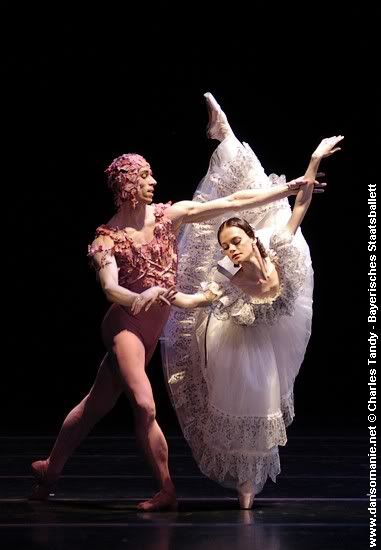
(left, performance from 1930-1935; right, from 2009)
Image Source: http://nla.gov.au/nla.pic-vn3411690-v
http://www.forum-dansomanie.net/pagesdanso/images/Ballettfestwoche_2009_Munich/kolb_selina_spectre_de_la_rose.jpg
6. L'après-midi d'un faune [Afternoon of a Faun]. By Claude Debussy. Chor. Vaslav Nijinsky. Ballets Russes. Théâtre du Châtelet, Paris. May 1912.
If you skipped through the previous song, please listen to Debussy's L'après-midi d'un faune (it's even better with your eyes closed). Yes, it is ten minutes long, but it is extremely impressive and expressive, embodying a large range of emotions. The french horn and flute at the beginning are haunting and it only gets better from there.
If that's not convincing enough, this is considered one of the first modern ballets and was very controversial for its time. It was sexually explicit, with an ending scene of simulated masturbation. Additionally, the ballet was presented in bare feet and rejected classical formalism/aesthetics.
 7. Daphnis et Chloé. By Maurice Ravel. Chor. Michel Fokine. Ballets Russes. Théâtre du Châtelet, Paris. 8 June 1912.
7. Daphnis et Chloé. By Maurice Ravel. Chor. Michel Fokine. Ballets Russes. Théâtre du Châtelet, Paris. 8 June 1912.This ballet is often considered Ravel's masterpiece for orchestra. It has a deep, passionate tone. The work was written for a large orchestra. In addition to the traditional instrumentation, it incorporated less common instruments such as alto flute, celesta, and crotales. Furthermore, it included a wordless choir, strings in eight parts, and a wind machine.
Image Source: http://www.danser-en-france.com/compagnies/vienne/Vienneballet_fichiers/image026.jpg
8. Thamar. By Mily Balakirev. Chor. Michel Fokine. Ballets Russes. Théâtre du Châtelet, Paris. 20 May 1912.
Thamar is another composition written only for piano. The transcription in the clip is with two pianos. Balakirev was known for promoting musical nationalism and fused traditional Russian folk music with experimental classical music techniques and styles. He was slow in completing his works for the public, which unfortunately, robbed him of credit for his inventiveness.
9. Jeux. By Claude Debussy. Chor. Vaslav Nijinsky. Cond. Pierre Monteux. Ballets Russes. Théâtre des Champs-Elysées, Paris. 15 May 1913.
Debussy's Jeux (meaning "Games" in French) has ominous, eery tones. The trilling notes and use of crescendos and decrescendos (varying volume of sound) create suspense. The score was written quickly and not well received, as it was soon overshadowed by Stravinsky's Le Sacre du Printemps which debuted two weeks later (and is the next song of the playlist).
10. Le Sacre du Printemps [The Rite of Spring]. By Igor Stravinsky. Chor. Vaslav Nijinsky. Ballets Russes. Théâtre des Champs-Elysées, Paris. 29 May 1913.
Le Sacre du Printemps was a succès de scandale ("success from scandal") with its radical departure from classical ballet. It had abstract, complex relations of rhythm and a primitive style of dance to depict fertility rites (there was also a staged blood sacrifice). Audience riot and a shower of bad press and criticism followed. The attention nearly made it an overnight success.
Composer/conductor Leonard Bernstein has said of Le Sacre du Printemps, "...it's got the best dissonances anyone ever thought up, and the best asymmetries and polytonalities and polyrhythms and whatever else you care to name."
It had such a profound effect on composition that "virtually all subsequent 20th century music could be said to be 'The Rewrite of Spring'", as American composer and parodist Peter Schickele voiced.
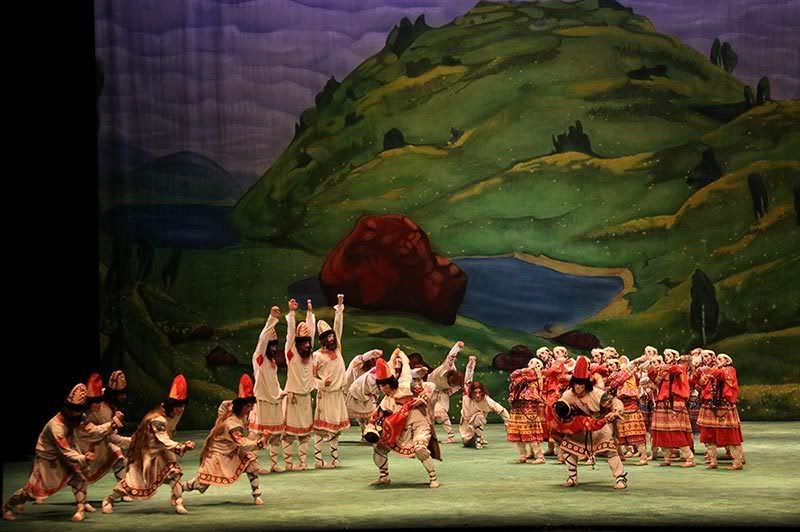
Image Source: http://www.ballet.co.uk/images/hamburg/hb-rite-of-spring-company-thrust_800.jpg
11. Le Coq d'Or [The Golden Cockerel]. By Nicolas Rimsky-Korsakov. Chor. Michel Fokine. Diaghilev's Ballets Russes. Paris Opera, Paris. 24 May 1914.
Le Coq d'Or is an opera-ballet that was composed as a "razor-sharp satire of the autocracy, of Russian imperialism, and of the Russo-Japanese war" (wikipedia.org). The war with Japan was highly unpopular among the Russian people and was a military disaster. When the piece was finished in 1907, it was immediately banned by the Palace - the resemblance between Tsar Nicholas II and the king in the ballet was too close.
12. Parade. By Erik Satie. Chor. Leonide Massine. Plot by Jean Cocteau. Ballets Russes. Théâtre du Châtelet, Paris. 18 May 1917.
Parade was another succès de scandale - it was described as "a kind of surrealism" three years before surrealism emerged as an art movement in Paris.
Several factors made this ballet signficant:
- it was Satie's first ballet, which he worked on with avant-garde artist Jean Cocteau
- Pablo Picasso did the set and costume design
- it brought common street entertainments to the elite with its use of "noise-making" instruments (tyepwriter, foghorn, milk bottles, etc.)
- and on an amusing note, Satie wrote a postcard to a critic that said: "Sir and Dear Friend, You are not only an arse, but an arse without music. Signed, Erik Satie." He was sentenced to eight days in jail as a result.
13. La Boutique Fantasque. By Gioacchino Rossini. Arr. by Orttorino Respighi. Chor. Leonide Massine. Ballets Russes. Alhambra Theatre, London. 5 June 1919.
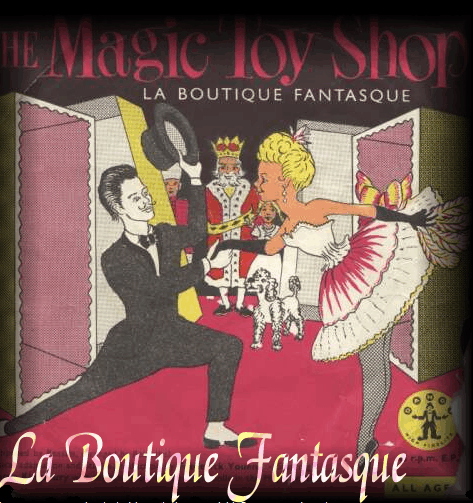
La Boutique Fantasque ("The Magic Toy Shop") is a love story between two can-can dancer dolls. Can-can dancing has often appeared in ballet and most notably so in this one. The score appropriately sets the scene of a toy shop with its cheerful, rushing melody and staccato rhythm.
Image Source: http://en.wikipedia.org/wiki/File:La_Boutique_Fantasque.PNG
14. Pulcinella. By Igor Stravinsky. Chor. Leonide Massine. Ballets Russes. Paris. 15 May 1920.
Pulcinella marked the beginning of Stravinsky's neoclassical work. This piece took a look backwards at 18th century musical styles and elements such as a clear, linear melody and contrast in sound between orchestra and solo instruments.
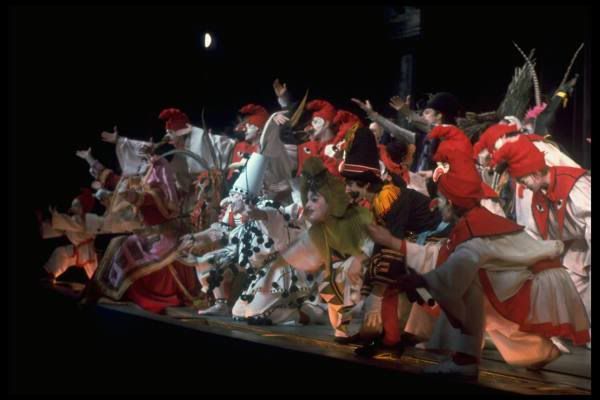
Image Source: http://www.neoclassic.com/wp-content/uploads/2009/07/Pulcinella.jpg
Neoclassic Chic:
Romanticism, which prevailed during the 19th century, embodied freedom, movement, and passion. As a result, the heavy musical experimentation that took place from 1910 to 1920, left some composers wanting to reconnect with musical tradition. In addition, after WWI, there was a general return to rational models in the arts.
Neoclassicism ("new classicism") was a musical movement that emerged in the 1920's. It combined the old ideals of order, balance, and control from the Classical period with newer trends that were emerging in the early 20th century, such as nonstandard rhythms and dissonances. The traits that Neoclassicism encompassed were simplicity, objectivity, clarity, and precision.
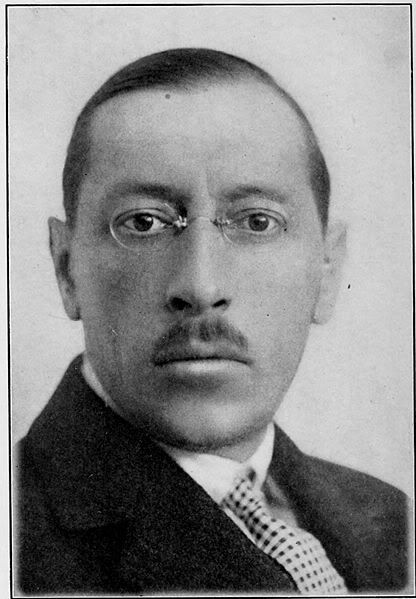 Igor Stravinsky was one of the most notable composers of Neoclassicism. Stravinsky's aesthetic was "stripped-down and form-oriented." He described it as "an arrangement of tonal masses sculptured in marble... to be regarded objectively by the ear" - a return to an architectural approach. In addition, his technical simplicity, lack of expressive quality, and use of repetition embodied a youthfulness.
Igor Stravinsky was one of the most notable composers of Neoclassicism. Stravinsky's aesthetic was "stripped-down and form-oriented." He described it as "an arrangement of tonal masses sculptured in marble... to be regarded objectively by the ear" - a return to an architectural approach. In addition, his technical simplicity, lack of expressive quality, and use of repetition embodied a youthfulness. Stravinsky reexamined the works of Mozart and Bach, and their contemporaries. He was also engaged with popular music, "music from the streets", which made his work commercially viable and able to win over a large public. He could take a piece of preexisting music, take it apart, and put it back together to create "something akin to a cubist version of the original."
The composer reflected that "in borrowing a form already established and consecrated, the creative artist is not in the least restricting the manifestation of his personality. On the contrary it is more detached and stands out better when it moves within the definite limits of convention." (http://library.thinkquest.org/27110/periods/neoclassicism.html)
Image Source: http://en.wikipedia.org/wiki/File:Igor_Stravinsky_Essays.jpg
Meanwhile:
In the 1920's, French designer Coco Chanel emerged as the fashion powerhouse that the name still holds to this day. Her designs came to be representative of social change and shifts in attitude that called for greater freedoms for women. Chanel believed that women should dress for themselves, not their men. This was reflected with a lean towards androgynous fashions - an "easy fitting, comfortable, graceful, straight-lined model" that expressed "modern freedom and frankness." Chanel's aesthetic was undecorated and architectural (perhaps her most iconic design being the little black dress). In addition, she emphasized uniform dressing based on standardization and repetition, rather than the one-of-a-kind couture that was made to order by individual customers. The term "neoclassic", which could be used to describe the designs of Chanel, was an outdated style in fashion. Its connotations suggested the draped garments of Greek and Roman attire - long, high-waisted tunic dresses. Thus, the more neutral term, "chic", was used.
Chanel had been in attendance for the preview performance of The Rite of Spring in 1913 and had established herself in the Ballets Russes clique. Between 1914 and 1919, the Ballets Russes was struggling both aesthetically and financially in the aftermath of the war. The financial support of the French and Russian aristocracy that Diaghilev strongly depended on had collapsed. For a dramatic comeback, he planned a Paris revival of The Rite of Spring with original sets, costumes, and score and choreography by his new lead dancer Massine. Chanel wrote Diaghilev a check for 200,000 French francs to cover the costs of production. Perhaps not surprisingly so, because around this time, Chanel and Diaghilev's star composer Igor Stravinsky were in the midst of an affair.
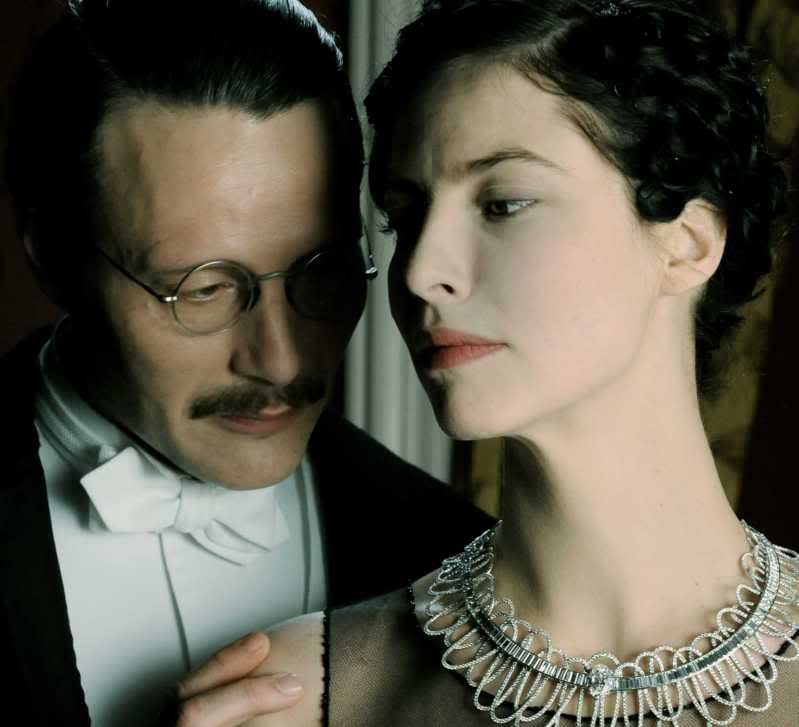 This liaison between designer and composer paralleled the "neoclassic" in music and "chic" in fashion. Both expressed simplicity, emphasis on repetition, architecture over ornamentation, and engagement with what what Chanel called "the streets." The concepts of neoclassicism and chic brought "an idealized classical past into contact with aspects of contemporary life... [and] encouraged intersecting modernisms."
This liaison between designer and composer paralleled the "neoclassic" in music and "chic" in fashion. Both expressed simplicity, emphasis on repetition, architecture over ornamentation, and engagement with what what Chanel called "the streets." The concepts of neoclassicism and chic brought "an idealized classical past into contact with aspects of contemporary life... [and] encouraged intersecting modernisms." The "idea that elements of everyday culture could be the foundation for sophisticated style informed Chanel's decision to create upscale interpretations of workaday garments much as it informed Stravinsky's decision to appropriate popular tunes and rhythms for his compositions."
Was this coincidental? Did it simply come about due to their relationship? Perhaps. Historians believe it was more likely tied to Chanel and Stravinsky's shared engagement with a broader culture of style that prevailed in elite Parisian circles after the war. Their affair came to an end in February 1921. Though they were unsuccessful with their relationship, their work was a significant collision of fashion and music.
Image Sources: http://i.models.com/feed/i/2008/12/chanel06.jpg
http://images.allmoviephoto.com/2009_Coco_Chanel_and_Igor_Stravinsky/2009_coco_chanel_and_igor_stravinsky_002.jpg15. The Sleeping Beauty. By Pyotr Tchaikovsky. Chor. Marius Petipa. Based on La Belle au bois Dormant by Charles Perrault. Alhambra Theatre, London. 1921.
The Sleeping Beauty has become one of the classical repertoire's most famous ballets, based on the Brothers Grimm's version of a fairy tale. The oboe and strings in the clip are graceful and gliding, then begin to quicken as flutes take over the melody. I strongly recommend watching it - the choreography, costume, and set design are beautiful and admirable even if one doesn't have an appreciation for ballet.
16. Renard. By Igor Stravinsky. Chor. Bronislava Nijinska. Cond. Ernest Ansermet. Ballets Russes. Théâtre de l’Opéra, Paris. 18 May 1922.
 Renard ("The Fox") is another opera-ballet. Based on Russian folk tales, this is a burlesque tale of humorous theatrics involving parody and exaggeration (not the striptease kind of burlesque). Stravinsky wanted to avoid the standard operatic staging and conventions. He created a new form of theater in which "the acrobatic dance is connected with the singing, and the declamation comments on the musical action." The clip is worth watching - the animal costumes and animal-like movements as dance are very imaginative.
Renard ("The Fox") is another opera-ballet. Based on Russian folk tales, this is a burlesque tale of humorous theatrics involving parody and exaggeration (not the striptease kind of burlesque). Stravinsky wanted to avoid the standard operatic staging and conventions. He created a new form of theater in which "the acrobatic dance is connected with the singing, and the declamation comments on the musical action." The clip is worth watching - the animal costumes and animal-like movements as dance are very imaginative. (original sketch of Renard's costume, right)
Image Source: http://en.wikipedia.org/wiki/File:Larionov_Renard.jpg
17. Les Noces [The Wedding]. By Igor Stravinsky. Chor. Bronislava Nijinska. Plot by Jean Cocteau. Ballets Russes. Théâtre de la Gaîté-Lyrique, Paris. 13 June 1923.
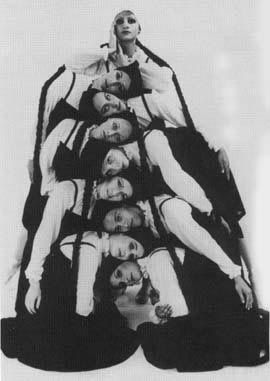 Another Stravinsky opera-ballet. Les Noces combines Russian folk song, irregular rhythms, and has a rather harsh, abrasive sound. The rhythms, and some of the choreography in this clip, remind me of those used in his earlier ballet Le Sacre du Printemps (1913). Les Noces is rarely recorded or staged because it can be so challenging to the ears of a typical audience. It is also a difficult piece, requiring soloists to sing dozens of syllables in rapid succession. Upon seeing the premiere, critic Alfred Kalisch said it was "enough to convert intending brides and bridegrooms to celibacy." Ouch.
Another Stravinsky opera-ballet. Les Noces combines Russian folk song, irregular rhythms, and has a rather harsh, abrasive sound. The rhythms, and some of the choreography in this clip, remind me of those used in his earlier ballet Le Sacre du Printemps (1913). Les Noces is rarely recorded or staged because it can be so challenging to the ears of a typical audience. It is also a difficult piece, requiring soloists to sing dozens of syllables in rapid succession. Upon seeing the premiere, critic Alfred Kalisch said it was "enough to convert intending brides and bridegrooms to celibacy." Ouch.Image Source: http://reserve.sp.ru/opera/foto/repert/svadebka.jpg
18. Jack-in-the-Box. By Erik Satie. Chor. George Balanchine. Ballets Russes. 1926.
Satie's Jack-in-the-Box is much easier on the ears than the previous piece. The piano notes peacefully prance and have a light, playful tone. Satie always thought he had lost the manuscript to this score on a bus. It was found after his death, crammed down the back of his piano.
(http://www.discogs.com/Erik-Satie-Gymnop%C3%A9dies-Parade-Jack-In-The-Box-La-Belle-Excentrique-Les-Aventures-De-Mercure/release/1417406)
(http://www.discogs.com/Erik-Satie-Gymnop%C3%A9dies-Parade-Jack-In-The-Box-La-Belle-Excentrique-Les-Aventures-De-Mercure/release/1417406)
19. Apollon Musagète [Apollo]. By Igor Stravinsky. Chor. George Balanchine. Ballets Russes. Théâtre Sarah Bernhardt, Paris. 12 June 1928.
Another neoclassical ballet by Stravinsky. He took its inspiration from the grand tradition of French 17th and 18th century music. The choreography is neoclassical as Balanchine bent the angles of the arms and hands. In 1929, the costumes were redesigned by Coco Chanel.
20. Le Fils Prodigue [The Prodigal Son]. By Sergei Prokofiev. Chor. George Balanchine. Ballets Russes. Paris. 1929.
Prokofiev was another composer that was prominent in the neoclassical movement. The premiere of Le Fils Prodigue took place in what was to be the Ballets Russes last season in Paris.
Image Source: http://userserve-ak.last.fm/serve/_/16159651/Sergei+Prokofiev.jpg
Conclusion:
This playlist examined the concept of establishing a national identity through music. The importation of foreign musics to Russia, under Peter the Great's reforms, essentially took over and replaced Russia's musical identity. This illustrates how music can work "to reproduce, reinforce, actualize, or memorialize extant sociocultural identities, in some cases also forcefully repressing both transformations and alternatives" (Garrett 137).
As Russian composers sought to establish a Russian national tradition in music, many innovative works were written. The fusion of folk songs and classical music styles took place, as well as experimentation with already-existing classical techniques. After a return to tradition, composers challenged it and looked for possibilities outside of the established conventions. Because the ballet scores were used in performance, it allowed for immediate reception and reactions from the people, which ultimately determined the success of the ballet. Many of the scandals and criticisms were in reaction to radically different styles. In addition to the musical innovations and changes, techniques of ballet were significantly impacted as well.
As described in depth earlier, Neoclassicism was a fusion of musical periods and marked a significant relationship of music and fashion. Furthermore, the Ballets Russes played an important role in establishing a strong collaboration between music and fashion/costume in the performing arts world. Overall, the playlist illustrates the impact and importance of social, political, and cultural moments in relation to music.
Sources:
http://www.dorak.info/music/national.htmlhttp://www.russianballethistory.com/
http://www.bbc.co.uk/radio3/classical/tchaikovsky/atoz/strav_n.shtml
http://library.thinkquest.org/27110/composers/stravinsky.html
Davis, Mary. "Chanel, Stravinsky, and musical chic.(Coco Chanel)(Igor Stravinsky)(Biography)." Fashion Theory 10.4 (2006): 431+. General OneFile. Web. 6 Apr 2010.
Garrett, Charles Hiroshi. Struggling to Define a Nation. Berkeley & Los Angeles: University of California Press, 2008. Print.

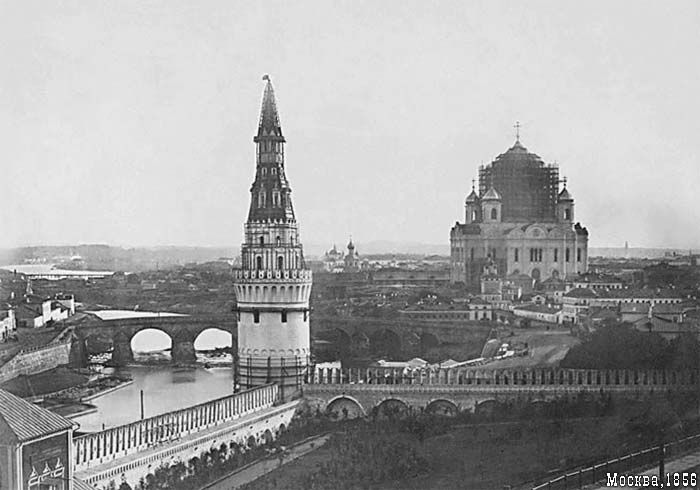
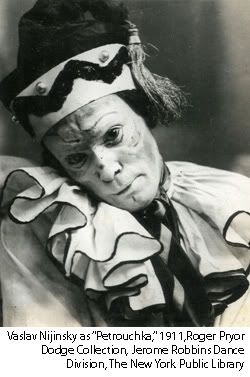

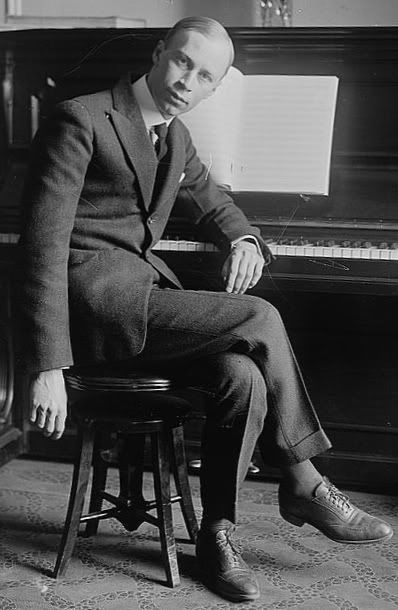
really one of the impressive manners about Ballet was originally intended for entertaining the royal court.
ReplyDeleteRachel Withers Ballet Instructor in UK | Certified ballet instructors in UK
You need to credit the Les Noce women’s tableau to Oakland Ballet Company!!
ReplyDelete